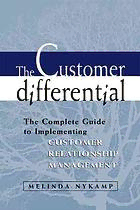Table Of ContentPage i
The Customer Differential
Page iii
The Customer Differential
The Complete Guide to Implementing Customer Relationship Management
Melinda Nykamp
Page iv
Special discounts on bulk quantities of AMACOM books are available to corporations, professional associations, and other organizations. For details, contact Special
Sales Department, AMACOM, a division of American Management Association,
1601 Broadway, New York, NY 10019.
Tel.: 2129038316. Fax: 2129038083.
Web Site: www.amacombooks.org
This publication is designed to provide accurate and authoritative information in regard to the subject matter covered. It is sold with the understanding that the publisher
is not engaged in rendering legal, accounting, or other professional service. If legal advice or other expert assistance is required, the services of a competent
professional person should be sought.
Library of Congress CataloginginPublication Data
Nykamp, Melinda.
The customer differential: the complete guide to implementing customer
relationship management/Melinda Nykamp.
p.cm.
Includes index.
ISBN 081440622X
1. Customer relations—Management. 2. Data mining. 1. Title.
HF5415.5 .N947 2001
658.8'12—dc21
00–050226
© 2001 Melinda Nykamp.
All rights reserved.
Printed in the United States of America.
This publication may not be reproduced, stored in a retrieval system, or transmitted in whole or in part, in any form or by any means, electronic, mechanical,
photocopying, recording, or otherwise, without the prior written permission of AMACOM, a division of American Management Association, 1601 Broadway, New
York, NY 10019.
Printing number
10 9 8 7 6 5 4 3 2 1
Page v
Contents
List of Illustrations ix
1. CRM: What It's Really All About 1
CRM Defined 4
The CRM Process 5
What Are the BottomLine Benefits of CRM? 10
2. Why Now? Why Me? 12
Why CRM Now? 12
Why My Organization? 19
3. It's All about the Customer Experience 22
Customer Understanding 22
Customer Purchase Cycle 25
Customer Needs 26
Customer Interaction Opportunities 27
Page vi
4. The CRM Transformation Process 31
Business Focus Transformation 32
Organizational Structure Transformation 33
Business Metrics Transformation 34
Customer Interaction Transformation 35
Technology Transformation 36
5. CRM Implementation 39
Step 1: Situation Assessment 41
Step 2: CRM Gap Analysis 44
Step 3: CRM Action Plan 47
Continued CRM Implementation 48
6. Changing Your Business Focus 49
Business Focus or Blur? 49
Big Challenge = Big Opportunity 50
Minimizing CRM Minimizes Your Success 51
The Focus of Most Organizations 52
The Leadership Imperative 56
7. Organizing around CRM 63
Defining the Organizational Structure 64
The Drivers of CRM Initiatives 67
Staff Training, Performance Measurement, and Compensation 69
8. Business Metrics and Analytics to Support CRM 73
Transforming Business Metrics 73
Product, Place, and Program Performance Measures 74
Customer Revenues 76
Customer Satisfaction 76
Customer Loyalty and Value 77
How to Develop CustomerFocused Metrics and Analyses 78
Page vii
9. Transforming Customer Interactions 87
Customer Interaction Transformation 89
The CRM Goal: Individual PermissionBased Interaction 97
10. Systems and Technology to Support CRM 101
Time in a Bottle 101
The CustomerCentric Technology Transformation 102
What Is a CRM System? 103
Overarching CRM Systems Issues 106
Before Your Purchase: Advice on Assessing Vendors 114
11. Measuring the Success of Your CRM Initiatives 119
Measurement of Internal CRM Capabilities 120
Measurement of Customer Interactions 122
Improvements in Customer Dynamics 122
Improvements in Operations 125
BottomLine Business Metrics 125
Where Do You Go from Here? 129
12. Case Study: Clothes Unlimited 132
13. Case Study: First Century Financial 141
14. Case Study: InTech Communications International 151
15. Case Study: Bluewater Technology Group 163
16. Case Study: Partners Insurance Company 173
Appendix A: Systems and Technology to Support CRM 181
Appendix B: CRM Opportunities 189
Appendix C: Glossary of Terms 194
Index 207
Page ix
List of Illustrations
Figure 11. Shift in focus. 5
Figure 12. The CRM process. 6
Figure 21. Customer expectations driven by CRM. 18
Figure 31. Customer Experience Cycle (detailed view). 23
Figure 32. Potential points of customer contact. 28
Figure 41. CRM Transformation Map. 32
Figure 51. CRM Transformation Map. 42
Figure 52. Customer experience cycle. 43
Figure 61. Business focus transformation. 52
Figure 62. Is your organization focused on the customer? 57
Figure 63. Think like the customer: Ten rules for building customer
relationships. 58
Figure 71. Organizational structure transformation. 64
Figure 72. Are you organized for effective CRM? 71
Figure 81. Business metrics transformation. 74
Figure 82. Key customer attributes. 79
Figure 83. Customer scorecard. 84
Page x
Figure 84. Does your organization have critical CRM metrics? 86
Figure 91. Customer interaction transformation. 91
Figure 92. ABC Capital's customer satisfaction findings. 94
Figure 93. Is your organization supporting individual permissionbased
interactions? 99
Figure 101. Customercentric technology transformation. 102
Figure 102. Integrated CRM business solution. 104
Figure 111. Five aspects of CRM measurement. 120
Figure 112. CRM Transformation Map. 121
Figure 113. Sample customer interaction scorecard. 123
Figure 121. Clothes Unlimited: enterprise overview. 133
Figure 122. CU Data Warehousing Taskforce. 135
Figure 131. First Century's services. 142
Figure 132. Highpriority consumer interaction scoreboard. 145
Figure 133. First Century's Transformation Mapping. 147
Figure 141. InTech's holdings. 152
Figure 151. BTG media expenditures. 164
Figure 152. BTG crosspurchase study. 165
Page 1
Chapter One—
CRM:
What It's Really All About
Imagine a world in which you could readily locate and purchase the products and services that you need, coupled with receiving ongoing relevant communications and
amazing service and support. Imagine that the provider understood:
· The products that are most relevant to you
· The price you are willing to pay
· The most effective way of communicating with you
· The level of service and support that you expect, and your preferred channels
· Their value to you, and your value to them
· What it would take to increase your loyalty
What if the provider not only knew this information, but also was willing and able to readily, consistently, and effectively act on

